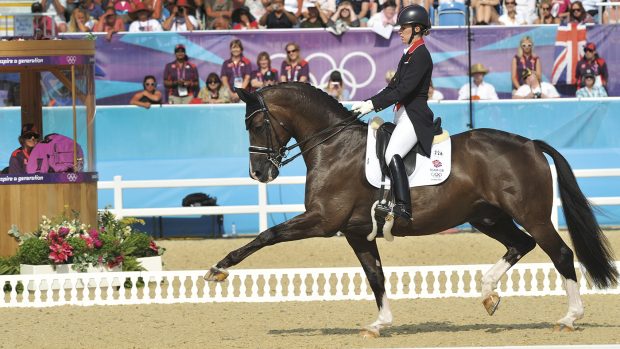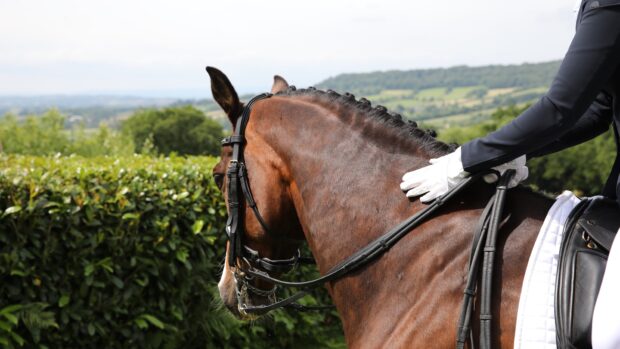In collected trot, the horse offers a shorter length of stride when compared to working, medium trot or extended trot.
What is collected trot?
The collected trot requires the horse to carry himself in a more condensed and uphill frame, while offering a shorter stride length.
It should not be slower in tempo than the working trot and the horse should maintain active impulsion and a regular two-beat rhythm throughout, as in all the variations of trot.
To perform a good quality collected trot, the horse needs to transfer the weight off the forehand back on to the hindquarters, creating more energy from behind so he can push himself uphill into the bridle.
The horse’s head and neck should not fall behind the vertical and you should aim for the horse’s face to be on the vertical, or slightly in front of the vertical depending on the horse’s conformation.
When is collected trot seen in dressage tests?
Under British Dressage rulings, collected trot is introduced in tests at elementary level. At this level, basic movements such as 10m circles and some lateral work is required to be ridden in collected trot, while some working trot movements are also retained. From medium level upwards, working trot no longer features in British Dressage tests.
What are the benefits of collected trot?
Teaching your horse how to work correctly in collected trot can be useful because it:
- Helps the horse develop more lift and cadence in the stride
- Helps the horse work from behind while lifting the forehand
- Moving from working to collected trot and back again helps the horse become more responsive to the aids
- Develops the horse’s strength and muscular development; as he needs more energy and impulsion to shorten his stride, he must make his hind legs work harder to push them underneath the body
- Adds variety to the training programme
How to ride collected trot
To ride a collected pace, you must be able to ride an effective half-halt, which will shift your horse’s weight back onto his haunches, bringing his hindlegs further underneath him and lifting his back.
Wrap your legs around your horse’s sides and keep your leg softly on to encourage your horse to continue moving forward with energy. Close your fingers around the reins to contain the extra energy, but without pulling back as this will block the horse and cause resistance.
The combination of these aids will adjust your horse’s forward momentum back onto his haunches. At first, ride with this level of collection for just a few strides only, and then revert to working or medium trot. Once the horse is strong enough, he will be able to maintain the collection for longer.
How to introduce collected trot
Aim to teach him to shorten his steps, but stay quick in the rhythm – he should not slow down. Begin by riding from trot to walk and then from trot to a ‘nearly walk’, then ride forwards again, and build from there.
Avoid staying in collected trot for too long – collect your horse for a few strides, then ride forwards again. It’s better to do a few good steps instead of staying in collected until he gets tired. As the collected trot develops, you’ll feel your horse becoming lighter in front and easier to manoeuvre.
A common exercise is to practise riding a few collecting strides on the short sides of an arena and returning to a working or medium trot on the long sides.
What you don’t want to see in collected trot
Avoid these pitfalls when training collected trot:
- Using the reins as the primary aid to collect the trot — this can cause the horse to shorten his neck and place his head behind the vertical.
- The rider slows the horse down rather than collecting the trot — don’t confuse speed and collection. The horse should maintain the same rhythm and tempo of pace he would offer in working trot. The aim is to shorten the stride, not slow the horse down.
- Asking for collection before the working trot is well established — before you ask your horse to train towards collected trot, you must ensure that he is comfortable in a balanced and swinging working trot. A good working trot should be active and rhythmical, while the horse remains relaxed with a free-moving shoulder. Once your horse has found his balance in the working trot, you can move onto asking for short periods of collected trot
- The horse isn’t responsive to the aids in the upwards and downwards transitions — if your horse doesn’t respond quickly off your leg and doesn’t understand how to move through the paces — for example, he can’t move from trot to walk, and walk to trot with a simple leg and seat aid — then you should work on this before you ask for different variations of trot. Ensuring your horse understands the half-halt is essential, too.
You might also be interested in:

What is lateral work, and how can it help my horse?

How to teach a horse extended trot – and other training tips from Anna Ross

Why the horse’s trot is the easiest pace to improve, plus other interesting facts

Subscribe to Horse & Hound magazine today – and enjoy unlimited website access all year round
Horse & Hound magazine, out every Thursday, is packed with all the latest news and reports, as well as interviews, specials, nostalgia, vet and training advice. Find how you can enjoy the magazine delivered to your door every week, plus options to upgrade your subscription to access our online service that brings you breaking news and reports as well as other benefits.




